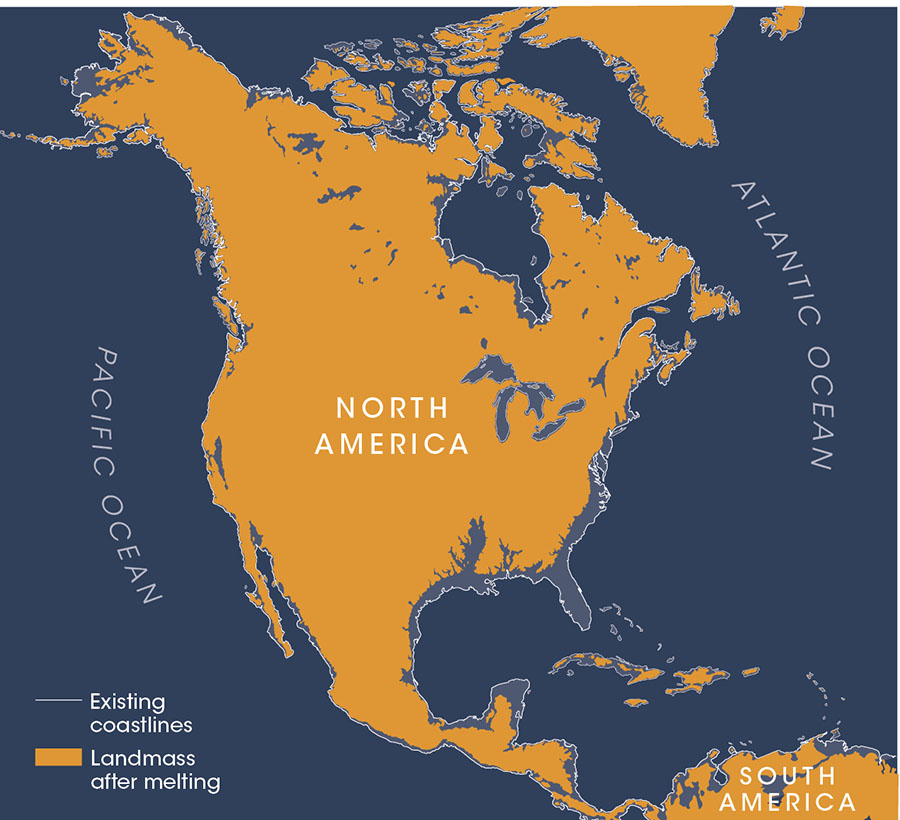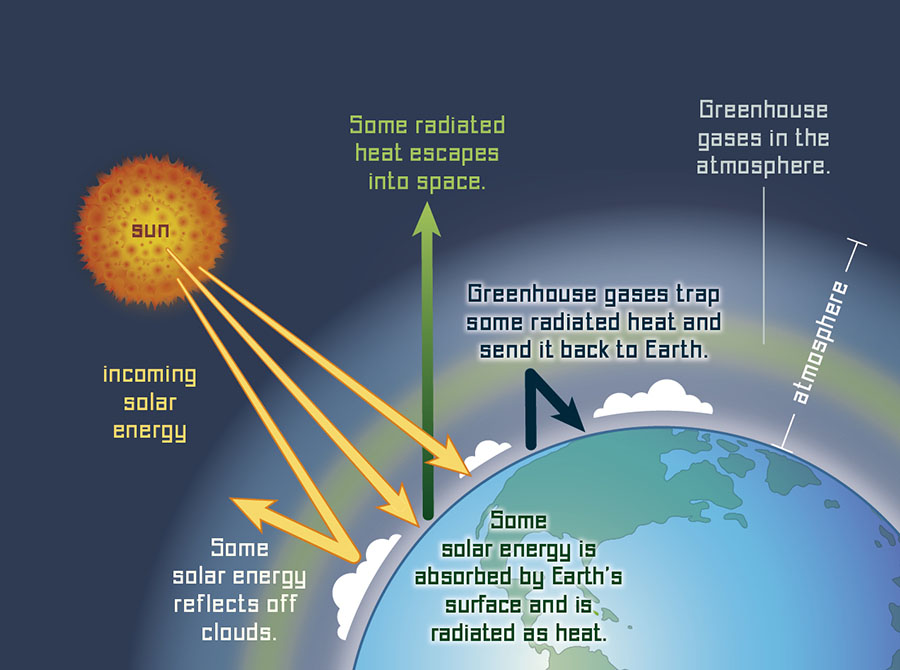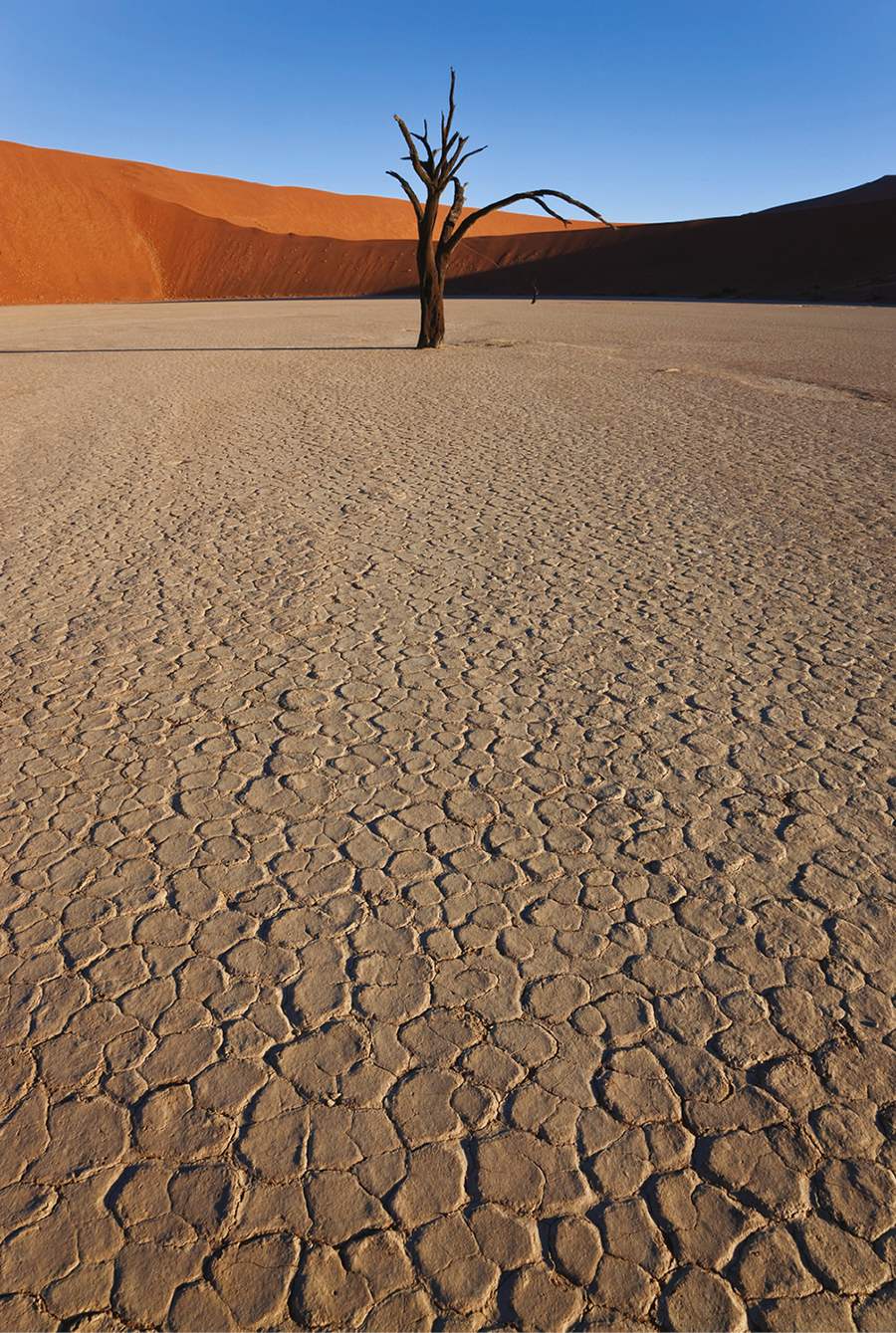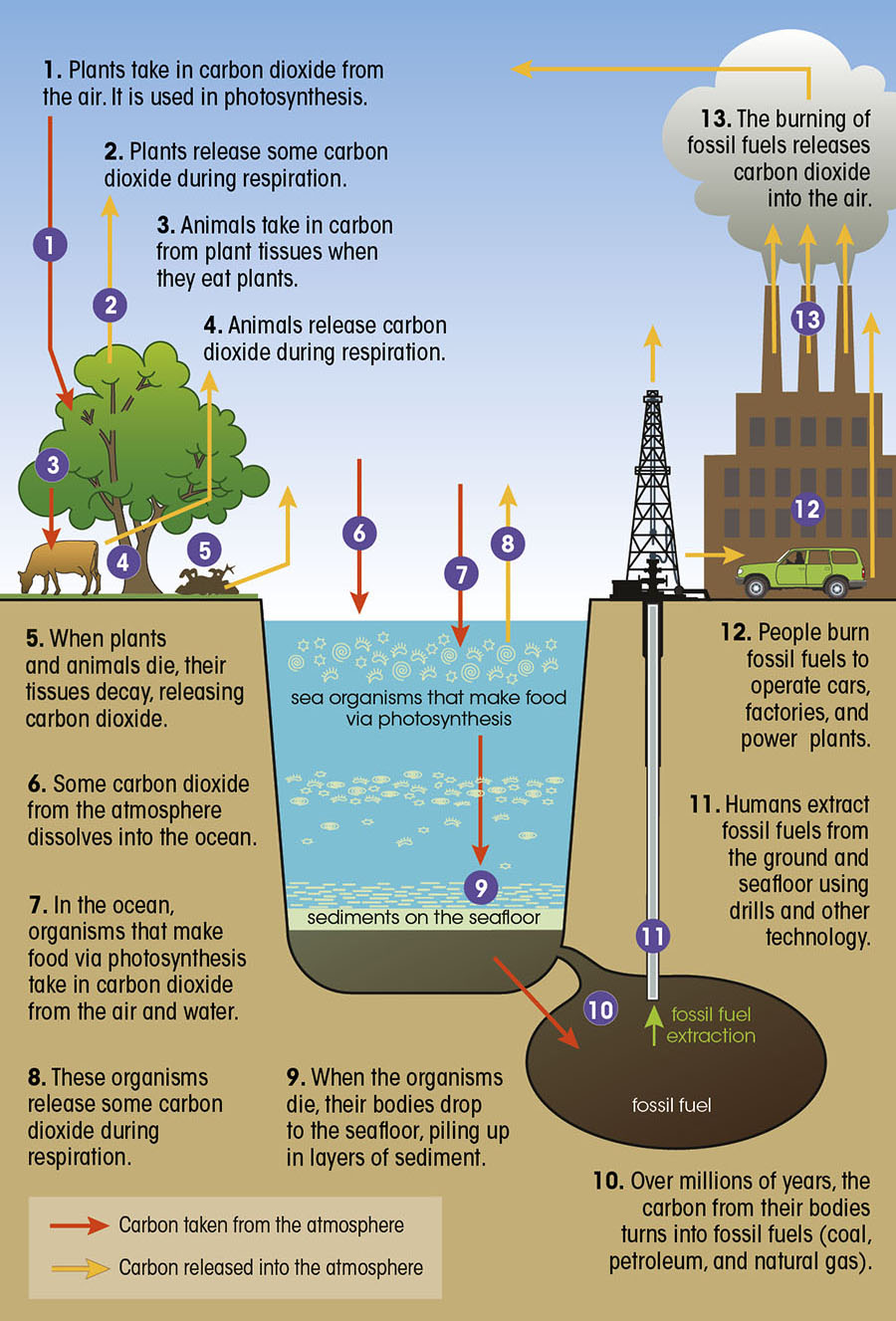One
An Abrupt Change in Climate
Rising seas. Flooded islands. Catastrophic droughts, tornadoes, and hurricanes. Scientists say that these trends, which have been increasing in the twenty-first century, are caused by climate change, created by the warming of Earth. Most scientists also say that humans have caused climate change by burning fossil fuels (coal, petroleum, and natural gas), which release heat-trapping gases into the atmosphere. As levels of these gases increase, the planet grows warmer. The higher temperatures have led to extreme weather events. Most experts agree that if humans don’t take action to prevent Earth from warming further, the climate will undergo even more drastic changes. And these will ultimately affect every living thing on Earth. What can humans do to counteract climate change?
Some engineers propose using geoengineering to tackle the problem. The prefix geo means “relating to Earth,” so geoengineering means “engineering Earth.” A more formal definition of geoengineering is the “active transformation of Earth’s climate through human intervention”—or using technology to reverse the effects of climate change. Sounds good, right? Maybe so. But geoengineering is one of the most complex and controversial topics in the world. Messing with Earth’s climate is a big deal and could have lasting consequences, both positive and negative.
Cra-ck!
Tiny cracks have appeared in a glacier (a large body of moving ice) along Evigheds Fjord in western Greenland. In the past, ice and snow completely covered the towering mountains that surround the fjord. But in the twenty-first century, dense rock is visible underneath the ice. The extremely cold weather that allows Greenland’s coastal mountains to remain covered in ice and snow year-round has changed. Warmer temperatures in Earth’s atmosphere are melting the top of the glacier, sending rivulets of ice water into the ocean. Warming waters of the North Atlantic Ocean are melting the glacier from the bottom as well.

Chunks of ice break off a glacier on the southeastern coast of Greenland and fall into the Denmark Strait. Warmer air and water temperatures are melting ice in Earth’s polar regions, causing sea levels to rise.
The melting glacier on the Evigheds Fjord is part of a much larger formation called an ice sheet. Earth has two major ice sheets—one on Greenland and one on Antarctica. Measuring more than 660,000 square miles (1.7 million square kilometers), Greenland’s ice sheet is approximately the size of Texas. On average, the ice sheet is 1 mile (1.6 km) deep. Its greatest depth is 3 miles (4.8 km). If it were to melt entirely, the total amount of water it contains would raise the oceans by about 23 feet (7 meters). The rising waters would flood the coasts of every country on the planet and submerge many inhabited islands.
While the probability of the entire Greenland ice sheet melting is slim, climatologists (scientists who study Earth’s climate) note that Greenland is shedding more ice during summer than it regains from snowfall in winter. The US National Aeronautics and Space Administration (NASA) reports that Greenland’s ice sheet is losing about 31 billion tons (28 billion metric tons) of ice annually. Some of the melting ice evaporates (turns into water vapor) or stays on the land, but most of it goes directly into the ocean. And studies show that the melting on Greenland is increasing every year.
NASA uses satellites to measure the depth of Earth’s oceans. The agency has noticed a definite rise in ocean levels over the last century, with an average yearly rise of about 0.13 inches (3.3 millimeters). While that may seem small, it adds up to a 4- to 8-inch (10- to 20-centimeter) rise over the past one hundred years. If that water were lying in the street, it could flow over curbs and into houses. If you were standing next to the ocean, the rising water would cover your legs to mid-calf. Imagine that much water flooding the entire world. And if the ice sheets continue to melt, the water levels will only get higher.
NASA climate scientist Jay Zwally says that the melting of Greenland’s ice sheet is like a “canary in a coal mine.” Before coal mines used modern air-quality detectors, miners sometimes took live canaries with them into mineshafts. If the birds stopped singing, miners knew that deadly carbon monoxide, which is frequently found inside coal mines, had risen to dangerous levels and killed the birds. Miners then knew it was time to hightail it out of the shaft.
NORTH AMERICAN COASTLINES BEFORE AND AFTER PROJECTED MELTING OF EARTH’S ICE

Sea levels have already begun to rise due to global warming. If all the polar ice on Earth were to melt, large areas of coastline would end up underwater. This map shows what North America would look like in that case. Florida would be submerged, along with vast stretches of coast along the Atlantic Ocean and the Gulf of Mexico.
Climatologists think of Greenland as a canary, or an early warning system, for the rest of the planet. Since the Greenland and Antarctic ice sheets account for almost 99 percent of all freshwater ice on the planet, the melting of either sheet would spell trouble. As Greenland warms and sheds its ice, so do other parts of the Arctic, including Alaska. Many climatologists think that the melted ice streaming into the Arctic Ocean and other northern waters is a signal that the canary has stopped singing. They say that climate change has reached a dire tipping point. Why is this occurring? The answer is related to Earth’s atmosphere.
A Delicate Balance
Earth’s atmosphere is composed of 78 percent nitrogen and 21 percent oxygen. The remaining 1 percent consists of argon and small amounts of greenhouse gases: methane, nitrous oxide, carbon dioxide, water vapor (water in gas form), and ozone. Greenhouse gases in the atmosphere act like a blanket, holding in heat and shielding Earth from certain kinds of radiation from the sun. When solar energy reaches Earth’s atmosphere, about 29 percent of it immediately bounces off clouds and gases and travels back into space. The atmosphere absorbs another 23 percent, while 48 percent of solar energy makes it to Earth’s surface. The land and the oceans absorb this energy and heat up.
The first law of thermodynamics, which applies to everything in the universe, says that energy can neither be created nor destroyed. That means that the amount of energy that goes into a system must equal the amount of energy that the system releases. So on Earth, at the same time the oceans and land are absorbing energy from the sun, they are also releasing energy in the form of infrared rays (heat).
THE GREENHOUSE EFFECT

The greenhouse effect is an exchange of energy that keeps Earth at a suitable temperature for living things. In this exchange, greenhouse gases in the atmosphere trap some of the sun’s heat near Earth. However, increasing amounts of greenhouse gases are trapping excessive heat, leading to global climate change.
When this heat rises and hits greenhouse gases in the atmosphere, the gases trap the heat and send it back toward Earth. This exchange of energy—from the sun down to Earth’s surface, back up to the greenhouse gases, and back down to the ground—naturally keeps Earth at an average temperature of about 59°F (15°C). This is a suitable temperature for life. Without greenhouse gases, our planet would be too cold for humans and many other living things. But if levels of greenhouse gases are too high, the planet will get too hot for living things.
The Fossil Fuel Habit
Since the Industrial Revolution, which began in Europe in the late eighteenth century, humans have been burning fossil fuels to power factories, vehicles, and machinery. Fossil fuels are formed from the remains of long-dead plants and animals—those that lived on Earth hundreds of millions of years ago. After these organisms died, over millions of years, layers of sand and mud accumulated over their bodies. As more layers built up, heat, pressure, and chemical changes turned these remains into fossil fuels: coal, petroleum, and natural gas.
When burned, fossil fuels release carbon dioxide, a greenhouse gas, into Earth’s atmosphere. By burning fossil fuels, humans add more than 9 billion tons (8.2 billion metric tons) of carbon dioxide to the atmosphere each year. Along with other greenhouse gases, the excess carbon dioxide causes the atmosphere to trap more heat than it naturally does. So Earth’s land and oceans are warming.
The Intergovernmental Panel on Climate Change—a body made up of scientists from around the world—notes that between 1880 and 2016, overall atmospheric carbon dioxide levels increased from 280 parts per million (280 molecules of carbon dioxide for each one million other molecules in the atmosphere) to 400 parts per million (ppm). For the past four thousand years, the amount of carbon dioxide in the atmosphere has hovered steadily around 280 ppm, so this big increase in just 150 years is alarming. Climatologists predict that once carbon dioxide levels reach 450 ppm, melting soil in Arctic regions will release millions of tons of methane, another greenhouse gas. The gas will increase warming further and will melt even more polar ice—an ongoing cycle.
Meet the Greenhouse Gases
Carbon dioxide is a gaseous form of carbon, a chemical element that is found in all living things. Plants take in carbon during photosynthesis—plants using sunlight, carbon dioxide, and water to make energy. Animals take carbon into their bodies when they eat plants. When animals exhale, they release carbon dioxide into the atmosphere. When dead plants and animals decay, they also release carbon dioxide. The movement of carbon dioxide between the atmosphere and living things is called the biological carbon cycle.
Humans have disrupted the biological carbon cycle in two ways. First, they have added excessive carbon dioxide to the atmosphere by burning fossil fuels. Second, they have cut down vast amounts of forests to make room for farms, homes, roads, and ranches. Like other plants, trees pull carbon dioxide from the air and use it during photosynthesis. With fewer trees taking in carbon dioxide, carbon dioxide levels rise even further.
While carbon dioxide makes up more than 75 percent of all the greenhouse gases that humans release into the atmosphere, it isn’t the only greenhouse gas on the rise. Methane normally enters the atmosphere when dead plants and animals decay. This process has been going on since life began on Earth. But in the modern era, vast amounts of methane also enter the air from human-made landfills, which contain tons of rotting food, plant waste, and other organic (formerly living) garbage. And livestock such as cattle release methane into the air when they burp and pass gas. A single cow expels 26 to 53 gallons (98 to 201 liters) of methane every day, and Earth is home to more than 1.3 billion cows.
Nitrous oxide levels are also rising due to human activity. Burning fossil fuels releases nitrous oxide into the air, but agriculture accounts for most of the increase. When farmers add nitrogen-based fertilizers to their fields to promote plant growth, bacteria in the soil convert the nitrogen into nitrous oxide. Animal manure, which farmers also use as fertilizer, contains large amounts of nitrous oxide as well.
High Water
Of all the greenhouse gases in the atmosphere, water vapor is the most abundant. It is also the gas that’s most involved with rain, snow, hurricanes, and other weather events. That means it plays a crucial role in climate change. As Earth’s temperature rises, more liquid water from oceans, lakes, and streams heats up and evaporates. More water vapor traps more heat and causes more warming—a self-perpetuating cycle.
And more water vapor in the air leads to the formation of more clouds and more precipitation. This makes wet areas of the planet wetter, as more water evaporates from Earth’s surface and returns to the planet as rain or snow. The extra heat and water in the air also gives more fuel to storms, making them more powerful. Climatologists say that climate change likely intensified some of the most powerful storms to hit the United States in the early twenty-first century, such as Hurricane Katrina in 2005 and Hurricane Sandy in 2012.
Contrary to what you might expect, more water vapor (and other greenhouse gases) in the air can make dry areas of the planet even drier. These places have very little water to begin with, and higher temperatures created by global warming evaporate what little they have. In dry places, the soil can be sunbaked and hard like cement. When rain does fall there, it doesn’t soak into the ground to water crops and other plants. Instead, it causes flooding and then quickly runs off the land into waterways.
Increasing droughts (periods of little or no rainfall) and higher temperatures have led to devastating forest fires in many places on Earth. Fires burn hotter and longer when the soil is dry and when dried-up dead vegetation sits on the land. The dry vegetation acts like kindling, providing fires with lots of fuel. Powerful fires devoured vast areas of wilderness in the western United States in the second decade of the twenty-first century. Climatologists say that climate change led to the dry and hot conditions that fueled the fires. And forest fires add even more heat-trapping carbon into the air, increasing warming further.

Drought in the African nation of Namibia has killed trees and dried out the soil. Climate scientists say that droughts will increase as Earth continues to warm.
Time to Act
Earth is already feeling the effects of excess greenhouse gases in the atmosphere. The heating up of air and the oceans has changed normal climate patterns, leading to violent storms, extreme droughts, record-breaking high temperatures, and melting ice sheets and glaciers. The changes are hurting animals, plants, and humans. For instance, the melting of glaciers is destroying the habitats (natural homes) of ice-dwelling animals such as polar bears. Rising water has flooded coastal areas worldwide, destroying the homes of people, plants, and animals. Warming ocean waters have killed corals and other sea life.
Experts say that to halt climate change, humans must greatly reduce the amount of carbon they release into the atmosphere. But doing so would not immediately lower carbon levels or global temperatures. John D. Sterman, a professor of system dynamics at the Massachusetts Institute of Technology near Boston, uses a simple visual image to explain increasing levels of carbon in the atmosphere. He describes a bathtub with the faucet flowing and with the drain at the bottom left unplugged. In this scenario, the bathtub represents Earth’s atmosphere. The water pouring from the tap represents carbon that humans are adding to the atmosphere by burning fossil fuels and cutting down forests. The water swirling down the drain is carbon that leaves the atmosphere naturally, via photosynthesis and other processes. But even with the drain unplugged, more water flows into the bathtub than leaves it.
The meaning of Sterman’s bathtub image is that even if we could turn off the tap of incoming carbon emissions completely, carbon dioxide levels would still be too high, and Earth would still be too warm. University of Chicago climatologist David Archer says that it would take hundreds of years for the extra carbon added by humans to swirl down the drain, returning Earth to preindustrial levels. Hundreds of years is too long to wait, most climate scientists say. To save our planet for future generations, humans need to find ways to reduce the threat immediately. That’s where geoengineering comes into the picture.

